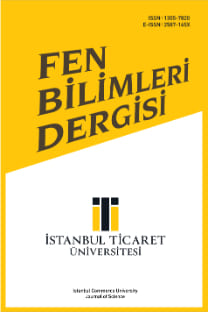HAVAYOLU EKİP ROTASYON OPTİMİZASYONU İÇİN GENETİK ALGORİTMA KULLANIMI
ekip rotasyonu, genetik algoritmalar, optimizasyon, Havayolu ekip planlama, sezgisel metodlar
GENETIC ALGORITHM APPLICATION FOR CREW PAIR OPTIMIZATION IN AIRLINE CREW PLANNING
Airline crew scheduling, crew pairing, genetic algorithms, optimization, heuristic methods,
___
- AhmadBeygi, S., Cohn, A., & Weir, M. (2009). An integer programming approach to generating airline crew pairings. Computers & Operations Research, 36(4), 1284-1298.
- Aksu, E. Ö., & Temiz, İ. (2021). Havayolu operasyonlarında dayanıklı ekip eşleme için eniyileme yaklaşımı: bir havayolu şirketi uygulaması. Politeknik Dergisi, 24(2), 417-429.
- Anbil, R., Tanga, R., & Johnson, E. L. (1992). A global approach to crew-pairing optimization. IBM Systems Journal, 31(1), 71-78.
- Arabeyre, J. P., Fearnley, J., Steiger, F. C., & Teather, W. (1969). The airline crew scheduling problem: A survey. Transportation Science, 3(2), 140-163.
- Aydemir, A. A. (2008). Havayolu ekip eşleme problemi: Genetik ve karma algoritmalar, Başkent Üniversitesi Fen Bilimleri Enstitüsü, Yüksek Lisans Tezi, 120, Ankara.
- Beasley, J. E., & Chu, P. C. (1996). A genetic algorithm for the set covering problem. European journal of operational research, 94(2), 392-404.
- Çankaya, G., & Arıkan, M. (2009). Sütun oluşturma yaklaşımı ile bir havayolu ekip çizelgeleme uygulaması. Journal of the Faculty of Engineering & Architecture of Gazi University, 24(1).
- Elhabashy, A. E., Elwany, M. H., Fors, M. N., & Abouelseoud, Y. (2014, Ekim, 14-16). Solving the airlıne crew pairing problem using genetic algorithms. CIE44 & IMSS’14 Proceedings. Istanbul. 2167-2181
- Ernst, A. T., Jiang, H., Krishnamoorthy, M., & Sier, D. (2004). Staff scheduling and rostering: A review of applications, methods and models. European journal of operational research, 153(1), 3-27.
- Etschmaier, M. M., & Mathaisel, D. F. (1985). Airline scheduling: An overview. Transportation Science, 19(2), 127-138.
- Graves, G. W., McBride, R. D., Gershkoff, I., Anderson, D., & Mahidhara, D. (1993). Flight crew scheduling. Management science, 39(6), 736-745.
- Gopalakrishnan, B., & Johnson, E. (2005). Airline crew scheduling: State-of-the-art. Annals of Operations Research, 140(1), 305-337.
- Holland, J. H., & Holland, J. H. (1975). Adaptation in natural and artificial systems: an introductory analysis with applications to biology, control, and artificial intelligence. University of Michigan press.
- Kornilakis, H., & Stamatopoulos, P. (2002, April). Crew pairing optimization with genetic algorithms. In Hellenic conference on artificial intelligence (pp. 109-120). Springer, Berlin, Heidelberg.
- Medard, C. P., & Sawhney, N. (2007). Airline crew scheduling from planning to operations. European Journal of Operational Research, 183(3), 1013-1027.
- Özdemir, U. (2009). Methodology for crew-pairing problem in airline crew scheduling, Boğaziçi Üniversitesi, Yüksek Lisans Tezi, 40, İstanbul.
- Rubin, J. (1973). A technique for the solution of massive set covering problems, with application to airline crew scheduling. Transportation Science, 7(1), 34-48.
- Rushmeier, R. A., Hoffman, K. L., & Padberg, M. (1995). Recent advances in exact optimization of airline scheduling problems. Dept. of Operations Research and Operations Engineering, George Mason University, Working Paper.
- Salazar-González, J. J. (2014). Approaches to solve the fleet-assignment, aircraft-routing, crew-pairing and crew-rostering problems of a regional carrier. Omega, 43, 71-82.
- Teodorović, D., & Stojković, G. (1990). Model for operational daily airline scheduling. Transportation Planning and Technology, 14(4), 273-285.
- Zeren, B. (2007). Genetik Algoritmalar ile Havayolu Ekip Planlamada Ekip Rotasyon Optimizasyonu, İstanbul Teknik Üniversitesi Fen Bilimleri Enstitüsü, Yüksek Lisans Tezi, 40, İstanbul.
- ISSN: 1305-7820
- Yayın Aralığı: 2
- Başlangıç: 2002
- Yayıncı: Doç. Dr. Necip Şimşek
ÇEVRE KOŞULLARININ ANITSAL YAPILAR ÜZERİNDEKİ ETKİLERİ
Halil İbrahim SAĞDIÇ, Leyla SURİ
BÜYÜK VERİDE ANONİMLEŞTİRME TEKNİKLERİ VE SALDIRI TÜRLERİ: UYGULAMA ÖRNEKLERİ
Hamza Talha GÜMÜŞ, Can EYÜPOĞLU
Gamze KABA, Seda BAĞDATLI KALKAN
OPTİMUM SIRALAMALI V-BLAST KULLANAN DİKGEN OLMAYAN ÇOKLU ERİŞİM
Furkan KARDAŞ, Mustafa Anıl REŞAT, Serdar ÖZYURT
PLANLANAN ÖZEL ETKİNLİK KATILIMCILARININ HARCAMA ANALİZİ: İKİLİ LOGİT MODELİ
Mahmut Esad ERGİN, Vail KARAKALE
ULUSAL BİLGİ VE İLETİŞİM GÜVENLİĞİ REHBERİ: IoT GÜVENLİĞİ İÇİN BİR UYGULAMA ÖRNEĞİ
Muttalip TULGAR, Abdül Halim ZAİM, Muhammed Ali AYDIN
Nermin Merve YALÇINKAYA, Fadime BAĞ, Muzaffer YÜCEL
DEMİRYOLU ARAÇLARININ BAKIM MASRAFLARININ RAMS ANALİZLERİYLE DEĞERLENDİRİLMESİ
